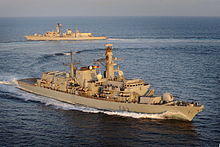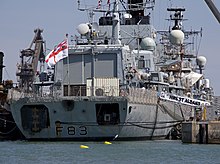HMS St Albans (F83)
She arrived in the region in early April, where her tasks included protecting Iraqi oil platforms as well as patrol duties in the northern Gulf.[14] During the trip, she provided a diplomatic role by visiting 16 countries, including Algeria, Albania, Ukraine, Romania, Bulgaria, Turkey and Lebanon.As a result, the Ministry of Defence announced on 17 July that year that St Albans had been redeployed to assist in Operation Highbrow, the evacuation of British citizens trapped in Lebanon.In May 2007, St Albans entered a period of maintenance that lasted over a year, with her crew temporarily reassigned to other vessels for the duration of the work.The maintenance programme took place in dry dock, situated in Rosyth, with a skeleton crew of engineers supervising the overhaul of several of the ship's systems."[20] Later in that deployment St Albans helped the Iraqi government "protect their oil platforms, and provide security to ensure regional stability".[22] On 1 July 2011, St Albans rescued 13 sailors off the coast of Oman from the stricken tanker MV Pavit, which had spent three days drifting in a heavy storm after losing power.[25] In March 2012, St Albans visited the Pool of London where she entertained a number of her affiliate organisations and other guests before returning to her home port of Portsmouth to conduct exercises in the Western Approaches.In June, St Albans visited the home of the German Navy in Kiel, joining in the huge maritime event attended by 50 countries, 2,000 yachts and pleasure craft and more than 5,000 yachtsmen and women.After completing her extensive Flag Officer Sea Training trails, based at Plymouth, she entered West India Dock, London on 7 July 2015 and then sailed back to Portsmouth.St Albans sailed for a nine-month mission to the Middle East on 27 November 2015, carrying a Merlin HM2 and ScanEagle unmanned aerial vehicle (UAV).In January 2017 she escorted the Russian aircraft carrier Admiral Kuznetsov along the English Channel on the latter's return voyage from Syria to Kola Bay.




HMS St AlbansUnited KingdomYarrow ShipbuildersPennant numberIMO numberMMSI numberType 23frigateCODLAGPaxman Valentaelectric motorsRolls-Royce Speynautical milesSeagnatSurface Ship Torpedo DefenceSea CeptorSea WolfHarpoon Block 1CNaval Strike MissileSting Ray torpedo4.5 inch Mk 8 naval gun30 mm DS30M Mk2 gunsMinigunsBrowning .50 caliber heavy machine gunsGeneral-purpose machine gunsAgustaWestland Merlin HM.2829 Naval Air SquadronRNAS CuldroseSting Ray torpedoesDepth chargesGeneral-purpose machine gunWildcat HMA2Sea VenomSting RayMartlethangarType 23 frigateRoyal Navysixth shipfrigatesDevonport, PlymouthRiver ClydeBAE SystemsYarrows YardScotstounGlasgowPride of PortsmouthdavitsCommanderOperation OracleArabian SeaFreedom of the CitySt AlbansGulf regionSuez CanalconflictMinistry of DefenceOperation HighbrowBeirutCyprussubmarineIrish SeaRemembrance SundayLondon Boat ShowRosythType 2087 sonar systemMerlin helicoptersHMS ArgyllNATO Response ForceMajorcaFaslanePersian GulfIraqi governmentGrand HarbourUSS George H. W. BushMarketors' CompanyWorshipful Company of HaberdashersSalcombeMerlin helicopterMiddle EastHMS Iron DukePool of LondonWestern ApproachesBritain's Ambassador to IcelandHvalfjörðurArctic convoysSoviet UnionHamburgGerman NavyCommonwealth CemeteryChannel IslandsHolyheadStavangerAmsterdam4.5" Mk.8 Mod 0 gunCatherine Jordan'Kryten' 4.5" Mod1 gunSea Wolf missilerelaunchedHMS BelfastNieuwe MaasRotterdamTrondheimFlag Officer Sea TrainingWest India DockGuard shipAmerica's CupScanEagleunmanned aerial vehiclecocaineDefence SecretaryMichael FallonAdmiral KuznetsovEnglish ChannelKola BaySubmarine Command Coursedry dockRoyal YeomanryAdmiral GorshkovNorth SeaAstuteSouth QuayLondonBabcockType 997 ArtisanBritish dukedoms